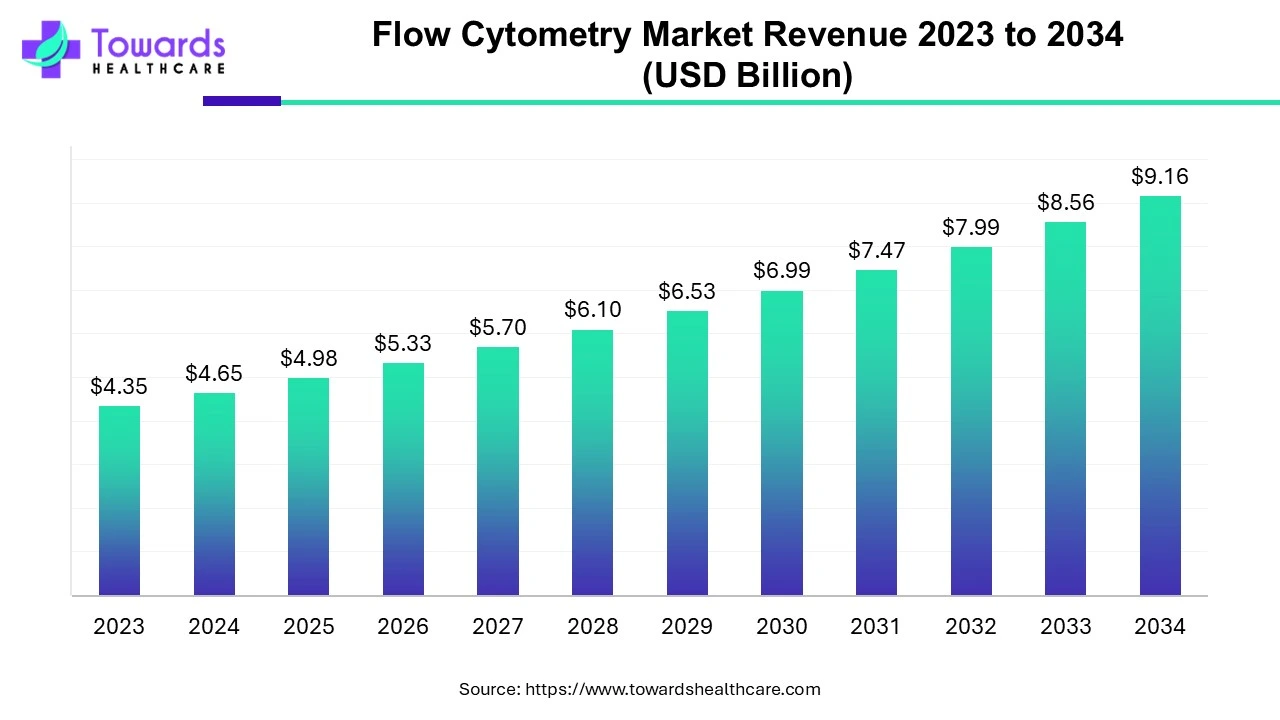The flow cytometry market was valued at $4.35 billion in 2023 and is projected to grow to $9.16 billion by 2034, at a compound annual growth rate (CAGR) of 7% from 2024 to 2034. This growth is driven by the rising prevalence of cancer, technological advancements, and an increase in research and development activities.


Flow cytometry is a laser-based technique used to detect and measure the physical and chemical properties of cells or particles. It is commonly applied to analyze bone marrow, blood, and other bodily fluids. This technology can perform a range of functions, including cell counting, sorting, assessing cell characteristics, detecting microorganisms, and identifying biomarkers. It is particularly useful in evaluating immune cells and characterizing cancer cells.
Flow cytometry has a wide range of applications in the medical field, including transplantation, hematology, tumor immunology, chemotherapy, prenatal diagnosis, neuroscience, genetics, and sperm sorting. The growing prevalence of hematological, cancer, and immunological disorders is driving the increased demand for flow cytometry, prompting advancements and further research in the field.
Flow cytometry is a versatile tool with applications across immunology, cancer research, stem cell research, and drug discovery. Many organizations are working on enhancing the technology to improve its speed, sensitivity, and multiplexing capabilities. There are also ongoing innovations in reagents and dyes used in flow cytometry to enhance cell visibility and enable more detailed analysis, such as integrating flow cytometry with mass spectrometry and single-cell analysis for deeper insights into cellular functions.
One of the main barriers to market growth is the high cost of flow cytometer instruments, which can range from $100,000 to $500,000. This high price limits accessibility, particularly in low- and middle-income countries. Additionally, variability in instruments from different manufacturers can make it challenging to standardize results and maintain reproducibility.
North America held the largest share of the flow cytometry market in 2023, driven by the presence of key players, technological advancements, and state-of-the-art research facilities. The region benefits from favorable government policies, such as initiatives from the National Institute of Standards and Technology (NIST) to accelerate the use of flow cytometry in biomanufacturing for cell and gene therapies. Additionally, Canada’s Canadian Immunology Quality Assessment Program aims to ensure accurate T-cell subset measurements using flow cytometry.
Asia-Pacific is expected to see the fastest market growth in the coming years. Rising chronic disease prevalence, increasing research investments, and growing demand for personalized medicines are fueling the growth in the region. China leads globally in flow cytometry research, with the highest number of published studies. Initiatives like the Ayushman Bharat Digital Mission in India and Japan’s Agency for Medical Research and Development support personalized medicine development, further driving market expansion.
By Product: Instruments Leading the Market In 2023, the instrument segment dominated the flow cytometry market. Flow cytometers, which precisely measure the properties of individual cells, are driving the growth of this segment due to continuous technological advancements.
Software Segment: Significant Growth Ahead The software segment is expected to grow significantly during the forecast period. Flow cytometry software plays a crucial role in analyzing complex multicolor data and converting raw information into readable results. It also offers advantages such as remote data access via mobile devices.
By Technology: Cell-based and Bead-based Segments In 2023, the cell-based technology segment held a substantial share, as it is commonly used for applications such as cell sorting, immunophenotyping, and cell proliferation assays. The bead-based segment is projected to see rapid growth due to its use in semi-quantitative analysis and detection of extracellular vesicles.
By Application: Clinical and Industrial Use The clinical segment was the largest in 2023, with flow cytometry playing a key role in diagnosing, monitoring, and treating diseases such as cancer and hematological disorders. The industrial segment, particularly in pharmaceuticals, microbiology, and food industries, is expected to grow at the highest rate, with applications in drug discovery and microbial fermentation.
By End-Use: Academic Institutions and Clinical Testing Labs Academic institutions dominated the flow cytometry market in 2023, as many install flow cytometers for advanced biomedical research. However, clinical testing labs are anticipated to see the fastest growth during the forecast period due to the widespread use of flow cytometry in clinical diagnostics and therapy monitoring.
The global biostimulants market is on a steady rise. Valued at USD 3.06 billion in 2024, it's expected to grow… Read More
The dental insurance market is booming. In 2024, it was valued at $232.07 billion, grew to $253.72 billion in 2025,… Read More
The global market for bipolar disorder treatments was valued at USD 9.74 billion in 2025 and is projected to grow… Read More
The global polio vaccine market is growing steadily and is expected to rise from USD 904.57 million in 2025 to… Read More
The global market for specialty medical chairs is on the rise. Valued at USD 5.12 billion in 2025, it's projected… Read More
The global rehabilitation equipment market is on a steady rise. Valued at USD 17 billion in 2024, it has grown… Read More